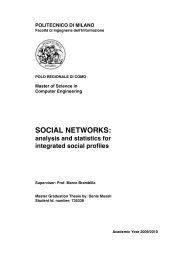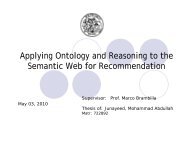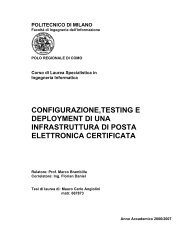Thesis full text (PDF) - Politecnico di Milano
Thesis full text (PDF) - Politecnico di Milano
Thesis full text (PDF) - Politecnico di Milano
You also want an ePaper? Increase the reach of your titles
YUMPU automatically turns print PDFs into web optimized ePapers that Google loves.
3.3.1.8 Instances of a class assuming values of known type on any property Pattern<br />
This pattern checks the existence of property values in the knowledge base assumed by<br />
properties of a known type. Then it deducts the instances to which they are being assigned. It<br />
encompasses three exploration components: (i) the Property Component configured with a<br />
PropertyWithType selection con<strong>di</strong>tion to retrieve the property with the given type in the<br />
knowledge base, (ii) the Property Value Component configured with a PropertyValueOfProperty<br />
selection con<strong>di</strong>tion to retrieve the property values being assumed by the previous properties, and<br />
(iii) the Instance Component configured with a InstanceOfClass and a<br />
InstanceWithPropertyValue selection con<strong>di</strong>tions and the BooleanOperator OR to retrieve the<br />
instances having at least one of the previous property values. The Complex Query class invokes<br />
the query component methods: the type input is transferred to the Property Component, the<br />
deducted properties are transferred to the Property Value Component, the class input and the<br />
deducted property values become the input for the Instance Component, and finally, the deducted<br />
instances are returned to the user.<br />
Figure 3.32: Instances of a class assuming values of known type on any property Pattern<br />
3.3.2 Knowledge Management<br />
The patterns for knowledge management are built on top of the management components for<br />
creating new UML elements or for removing existing ones under certain con<strong>di</strong>tions. The<br />
execution of these patterns has side effects on the knowledge base. Like in the case of<br />
exploration patterns, values are transferred from one component to the other either with user<br />
intervention or automatically. In the latter case, the methods invocation is done by the UML<br />
53



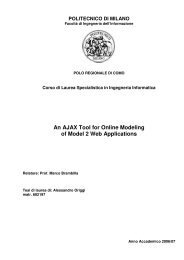
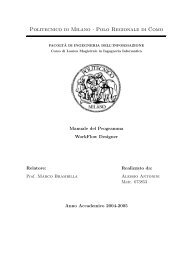
![Full text preview of the chapter [PDF] - Politecnico di Milano](https://img.yumpu.com/44021924/1/180x260/full-text-preview-of-the-chapter-pdf-politecnico-di-milano.jpg?quality=85)
